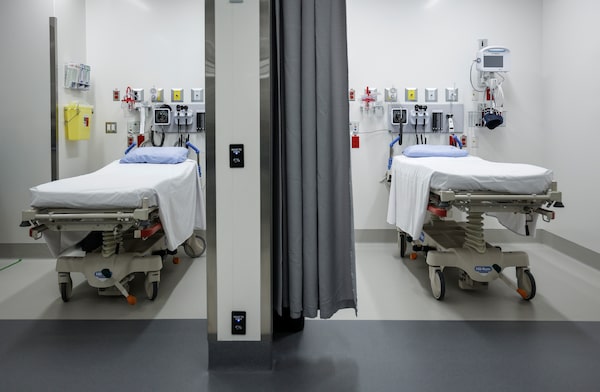
Treatment rooms in the emergency department at Peter Lougheed hospital in Calgary are pictured last year.Jeff McIntosh/The Canadian Press
First Nations patients are more likely to leave Alberta emergency departments before receiving care than other patients – and anti-Indigenous racism is a significant reason why, a new study says.
“The stories are incredibly powerful,” said Patrick McLane, the lead author of the study published Monday in the Canadian Medical Association Journal.
“First Nations people have said (that) sometimes it’s really obvious when there’s racism, but sometimes it’s not and it’s always present as a possibility,” McLane, an adjunct associate professor of emergency medicine with the University of Alberta, said in an interview.
Although the study was conducted in Alberta, the findings likely apply to emergency department visits across Canada, he said.
The researchers had previously analyzed data from more than 11.6 million emergency department visits in Alberta between April 2012 and March 2017. More than one million of those visits were made by First Nations patients.
The analysis found 6.8 per cent of First Nations patients left emergency departments either before being seen or against medical advice. That’s compared to just 3.7 per cent of non-First Nations patients.
In the current study, the researchers wanted to see if there were any other factors that could explain the discrepancy, so they went back to the data and controlled for several variables including patient demographics, reasons for coming to the emergency department and geography.
At the end of that analysis, First Nations status was the only apparent explanation for the difference in rates of leaving before receiving care, the study found.
“Leaving without completing care matters because it delays needed care and interrupts the care journey,” said Bonnie Healy, co-author of the study and former executive director of the Alberta First Nations Information Governance Center, which was a partner in conducting the research.
The study showed that First Nations people left the emergency department even when they had a serious illness or injury, including “long bone fractures,” which include broken arms and legs.
“Have you ever had a long bone fracture? … It’s painful,” said Healy, who has decades of experience as a registered nurse and is now the health director for the Blackfoot Confederacy.
“To walk away from care with a long-bone fracture is shocking to me,” she said in an interview.
About one in 20 patients in both First Nations and non-First Nations groups required hospitalization after leaving the ER and coming back another time, the study found.
To dig deeper into why First Nations patients left before receiving care, the researchers did a qualitative study with 64 people – including sharing circles with First Nations participants – as well as interviews and a focus group with health-care providers. The qualitative study was conducted between 2019 and 2022.
Both patients and health-care providers reported experiencing or witnessing anti-Indigenous racism and discrimination in emergency departments, including stereotyping by assuming alcohol and drug use.
One First Nations person who was in a vehicle crash and feeling dizzy said instead of being evaluated by a doctor, the emergency department staff immediately brought in an addictions counsellor.
“They thought I was on drugs or something in the waiting room,” the study participant said.
“I never do that stuff. That’s not why I’m here.”
The patient got up to leave but ran into their regular family doctor, who diagnosed a concussion right away, the study said.
A doctor reported seeing a First Nations girl who had abdominal pain overhear another physician going on a “big racist rant” at the nurses’ station in the emergency department.
The girl got up, took the IV out of her arm and “was bleeding on the floor” as she left, the doctor told researchers.
The doctor was convinced the girl had appendicitis and pleaded with her to get care.
“I don’t know what happened to her,” the doctor said.
Other study participants described First Nations patients being subjected to long waits.
“It’s almost like they’re put somewhere to wait it out. And they wait and they wait and they wait,” a health director working with First Nations patients said.
“They’re basically left waiting so these people get frustrated and they walk out because they don’t feel important enough to be seen.”
Other barriers, including limited transportation, also play a role in First Nations people leaving emergency departments before receiving care, the qualitative study found.
One participant described how people from rural First Nations may rely on others to give them a ride to the hospital on their way to do other errands in town – and the driver may not be able to wait as long as the emergency department visit takes.
“You didn’t get through triage yet, you’re still waiting (but you think) ’OK, my ride’s leaving back, my home is 1.5 hours away, how am I going to get home if I wait it out?’” the participant said.
“It’s really those social determinants (of health) that sort of come into play at that time,” they added.
McLane said he would “categorize that as an issue of systemic racism,” because First Nations people don’t have equal access to care.
The study findings are “unfortunately” not surprising, said Healy, who has personally seen racism play out over and over again in health care.
“I was the only First Nations (person) of my graduating class in 1990, so I had to witness this all throughout my career,” she said.
Canadian Press health coverage receives support through a partnership with the Canadian Medical Association. CP is solely responsible for this content.